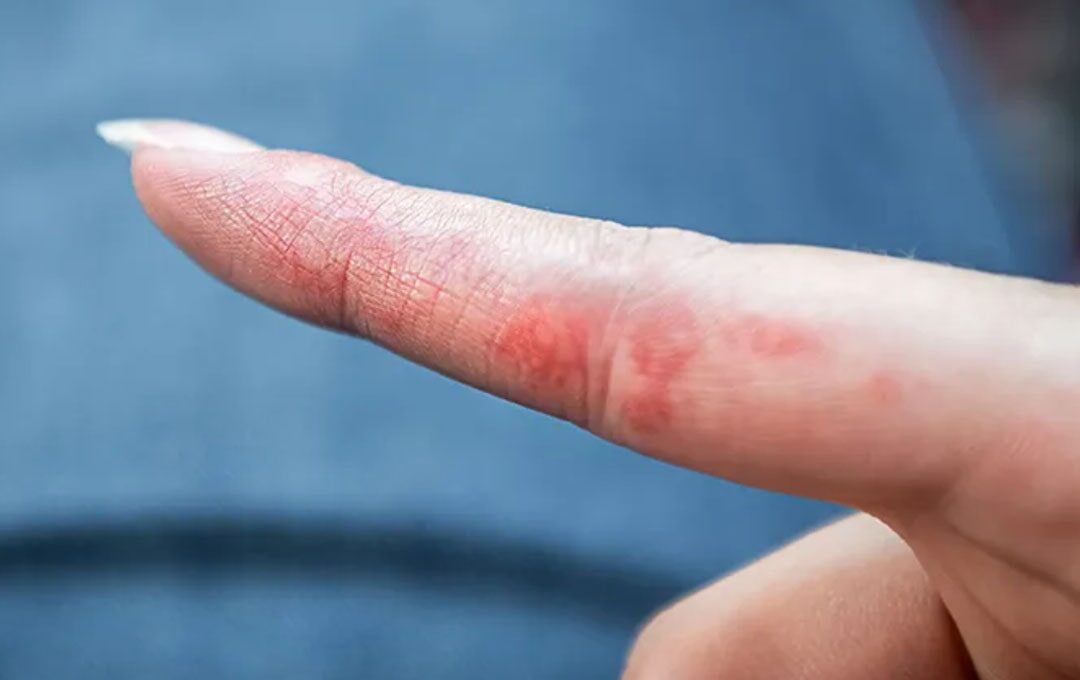Being worried about daily routines is natural. However, when things go wrong in life, stress can occur—and not just emotionally. Stress, especially emotional stress, can physically manifest in your body. As it suppresses the immune system, it can cause problems ranging from muscle aches to headaches. In other instances, stress may show as visual signs such as stress bumps on fingers, hands, or other parts of your body. They can be unsightly and uncomfortable, though usually not serious.
Causes and Treatments of Stress Bumps on Fingers
There are different types of stress bumps on your fingers, each with different causes, diagnoses, and treatments.
(1) Urticaria
The most common type of stress bumps on fingers are called hives and this is often associated with stress, which causes hormonal changes in the body, in turn causing the skin to become more sensitive and reactive, resulting in such manifestation on the fingers and hands.
Officially referred to as urticaria, these are skin lesions that appear round and reddishly fierce on your fingers. They may become inflamed and itchy or painfully uncomfortable though usually, such lesions may heal within two to three hours.
(a) Causes
When the immune system is unbalanced, it sends histamine—a chemical in certain body cells—to fight off a trigger (in this case, stress). But histamine can’t remove stress, so hives and eczema appear on your hands and fingers. Such lesions can also be triggered by sunlight, certain fabrics, temperature changes, and some foods.
Although hives can resolve by themselves within a few hours, chronic hives can last up to six weeks or longer. These bumps can be one-off or recurring if treatment is not sought and/or the underlying cause remains.
(b) Treatment
Since fingers are used constantly, treating hives there can be tricky. Some treatments include antihistamines such as Zyrtec or Benadryl, cool compresses or ice packs to reduce inflammation, topical ointments such as hydrocortisone creams, or natural topicals like aloe vera to relieve itching and pain. You can also protect fingers with gloves after applying these creams or ointments.
If the condition worsens, consult an allergy doctor immediately.
(2) Dyshidrosis (Dyshidrotic Eczema/Pompholyx)
Dyshidrosis, or dyshidrotic eczema, is a skin condition causing small fluid-filled, itchy blisters on the fingers (especially sides) and palms. In rare cases, they appear on the feet.
The blisters, which resemble tapioca grain-like clear fluid-filled bumps, can cause intense itching or pain, lasting about two to four weeks. After drying, the skin may become scaly. These painful blisters may recur even before previous ones heal completely. In severe cases, small blisters may merge into bigger ones.
Dyshidrosis tends to recur fairly regularly for months or years.
(a) Causes
The exact cause of dyshidrosis is unknown, but often associated risk factors include emotional or physical stress, exposure to certain metals such as cobalt and nickel, sensitive skin, other skin disorders like atopic dermatitis, skin infections, seasonal allergies, bacterial infections, or even exposure to wet environments or materials like cement.
Dyshidrosis is also more common in females and in people under 40 years old. NCC & AAD data say about 5-20% of hand eczema cases are due to dyshidrotic eczema.
(b) Treatment

Treatment plans include over-the-counter or home options like antihistamines, dietary changes, lotions, petroleum jelly, topical creams or ointments for the fingers or affected body parts. Itchy bumps can be treated with anti-itching creams. In more severe cases, corticosteroid pills like prednisone or injections, or light therapy such as ultraviolet treatments, may be prescribed.
(3) Shingles (Herpes Zoster)
Shingles is a painful skin rash usually appearing on chest/back, but occasionally as bumps on your fingers or hands. While rashes and blisters are common, mild cases of shingles may present only with red rashes without blisters. Severe symptoms include headaches, fever or extreme fatigue; mild cases usually do not cause such symptoms.
(a) Causes
This condition is caused by the varicella-zoster virus (same as chickenpox). If you’ve had chickenpox, the virus remains dormant and can reactivate later, especially when your immune system is compromised due to stress.
Risk factors increase if you are over 60, had chickenpox early in life, or are on long-term medications for pre-existing conditions.
(b) Treatment
Shingles usually clear up on their own within three to four weeks, although a doctor can prescribe antiviral medications such as acyclovir, famciclovir, or valacyclovir to reduce pain and speed up healing.
Emerging research continues to shed light on how common and stress-linked these finger skin conditions are. Here’s the latest data you can share with your healthcare provider.
New Insights on Stress Bumps/Dyshidrosis/Hand Eczema
A 2025 study in physicians showed 43.9% (95% CI 36.2-52.0%) of those surveyed reported hand eczema, which often overlaps with or includes stress-triggered conditions on fingers.
Another meta-analysis (2024) estimates 5-20% of hand eczema cases are dyshidrotic eczema, particularly affecting fingers, palms and feet.
Also, a Swedish study of 107,206 individuals found a diagnosed rate of 0.05% of dyshidrosis in general population; among hand dermatitis, dyshidrosis made up about 3% of cases in that population.
Managing Stress Bumps on Fingers and Hands
Stress bumps on fingers and hands are irritating since your fingers are constantly in use. It is therefore important to identify the cause so you can treat the condition effectively. If you’ve ruled out external factors or other allergies or conditions, the cause may just be stress-induced skin issues.
Managing your stress levels and monitoring anxiety increases may be the best solution. Avoid additional stressors, identify important ones, and apply appropriate solutions.
These may include a healthy diet, over-the-counter treatments, topical medications, antifungal medicines, diet control, and therapy. Skin care matters—determine whether your skin is dry, oily, or sensitive and use products suited to that type. Engaging in relaxing daily activities like massage, exercise (swimming or jogging), or hobbies such as knitting or sewing can help induce calm and inner peace, helping to keep the condition under control.

